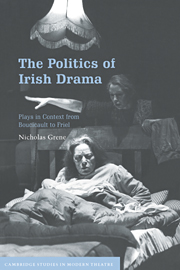Book contents
- Frontmatter
- Contents
- Acknowledgements
- Chronology
- List of abbreviations
- Introduction
- 1 Stage interpreters
- 2 Strangers in the house
- 3 Shifts in perspective
- 4 Class and space in O'Casey
- 5 Reactions to revolution
- 6 Living on
- 7 Versions of pastoral
- 8 Murphy's Ireland
- 9 Imagining the other
- Conclusion: a world elsewhere
- Notes
- Bibliography
- Index
Conclusion: a world elsewhere
Published online by Cambridge University Press: 22 September 2009
- Frontmatter
- Contents
- Acknowledgements
- Chronology
- List of abbreviations
- Introduction
- 1 Stage interpreters
- 2 Strangers in the house
- 3 Shifts in perspective
- 4 Class and space in O'Casey
- 5 Reactions to revolution
- 6 Living on
- 7 Versions of pastoral
- 8 Murphy's Ireland
- 9 Imagining the other
- Conclusion: a world elsewhere
- Notes
- Bibliography
- Index
Summary
The Irish plays keep on coming. In July 1997 The Weir, a new play by 26-year-old Conor McPherson, opened at the Royal Court Upstairs to such an enthusiastic reception that it transferred to the Royal Court main house in February 1998, to go on to be performed in Brussels and Toronto, a run in Dublin, a return to London, and on to Broadway in April 1999. The Weir is not a play about Ireland as such. The title refers to a local weir built by the Electricity Supply Board in 1951 ‘to regulate the water for generating power’ in the western area of Sligo-Leitrim where the play is set. It acts as a metaphor for the controlled release of emotion through talk and story-telling among the five characters, not as a symbol of a stage in the modernisation of Ireland. As McPherson himself says about the play, ‘I wasn't concerned with geography or politics. I am from the Republic of Ireland and that's where my plays have their genesis, but not from any need to address anything about my country.’ Still, The Weir is identifiably, recognisably, an Irish play, and a dimension to its (well-deserved) success comes from that recognisability. The small rural pub scene is familiar from as far back as the Playboy. The full-length action, uninterrupted by any interval, consisting in nothing but an evening's drink-talk, has a precedent in Murphy's Conversations on a Homecoming.
- Type
- Chapter
- Information
- The Politics of Irish DramaPlays in Context from Boucicault to Friel, pp. 261 - 268Publisher: Cambridge University PressPrint publication year: 2000



